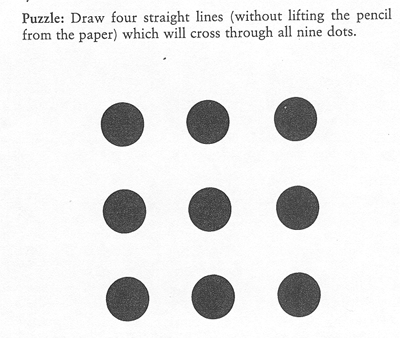Lateral Thinking
Please see the Sourcebook for Teaching Science (chapter 6) for more information.
Lateral thinking is the ability to approach problems from a variety of perspectives rather than only from the single most obvious approach. Consider the following question:
Example-1: On January 5, 2006, a jet traveled east from Quito, Ecuador at 800 km/hour. How far did it travel in three hours?
The standard way to approach this question is to calculate the distance relative to a point on the Earth’s surface by multiplying the speed of the jet (800 km/h) by the time in flight (3 hours). Alternatively, one could calculate the speed relative to the Earth’s center by factoring in the rotational speed of the earth at the Equator (1675 km/h) on which Quito sits. Another way to approach this question is to include the speed relative to the Sun, in which case one would also need to consider the Earth’s orbital speed of 107,826 km/h. Finally, one could consider other variables such as the directions and magnitudes of winds on January 5, 2006. Although such solutions may seem silly given the context in which such a question is traditionally asked, the ability to analyze the question from different perspectives is not. Lateral thinking exercises, such as those that follow, are used in corporations to help executives, engineers, planners and designers think of alternative solutions to the problems they face. One should remember that not all alternatives are of equal merit, and although it is important to think of alternative ways of doing things, it is also important to evaluate the relative merit of each.
Sample Questions (see Sourcebook for Teaching Science for answers)
1) A chemistry stockroom technician is 188 cm (6’ 2”) tall. What does he weigh?
(2) A rope ladder is hung over the side of research vessel in the Bay of Fundy so that the bottom rung just reaches the water. If the rungs are 20 centimeters apart, how many rungs will be under water when the tide rises 3 meters.
(3) A research ecologist drank heavily from punchbowl at a research picnic in the Himalayan Mountains. He left the party early and was surprised to find that all of his team came down with giardiasis (a waterborne disease) the next day, even though nothing was added to the punch after he left, and no one had drunk anything since the party.
(4) The younger of two twins celebrates her birthday two days before her older twin. How can this be if both twins are celebrating their birthdays on the calendar days on which they were born.
(5) A mineralogist examines seven crystals that are identical except that one has slightly less mass than the other six. How can the mineralogist determine which is the smallest crystal using just a double pan balance and two measurements?
(6) Why do civil engineers design round manhole covers rather than square ones?
(7) A botanist is growing plants in three sealed, windowless growth chambers, but can’t remember which of three light switches controls the light in chamber C, one hundred meters away. To minimize disturbance to the plants, he can open the chamber only once for five seconds. How can he determine which switch controls the light in chamber C?
(8) How far can an elk run into the woods?
(9) A boat is floating in the lock of a canal. What will happen to the water level in the lock if an anchor is thrown overboard?
(10) The following is a list of newspaper headlines that can be interpreted in different ways. Give the probable intended meaning and a humorous alternative interpretation.
-
Safety experts say school bus passengers should be belted
-
Teacher strikes idle kids
-
Squad helps dog bite victim
-
Miners refuse to work after death
-
Juvenile court to try shooting defendant
-
Stolen painting found by tree
-
Killer sentenced to die for second time in 10 years
-
Milk drinkers are turning to powder
-
Dealers will hear car talk at noon
-
Man struck by lightning faces battery charge

